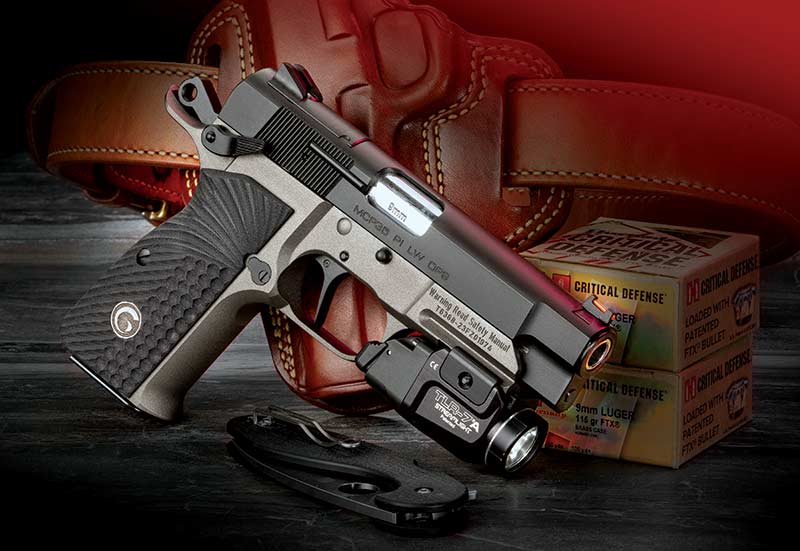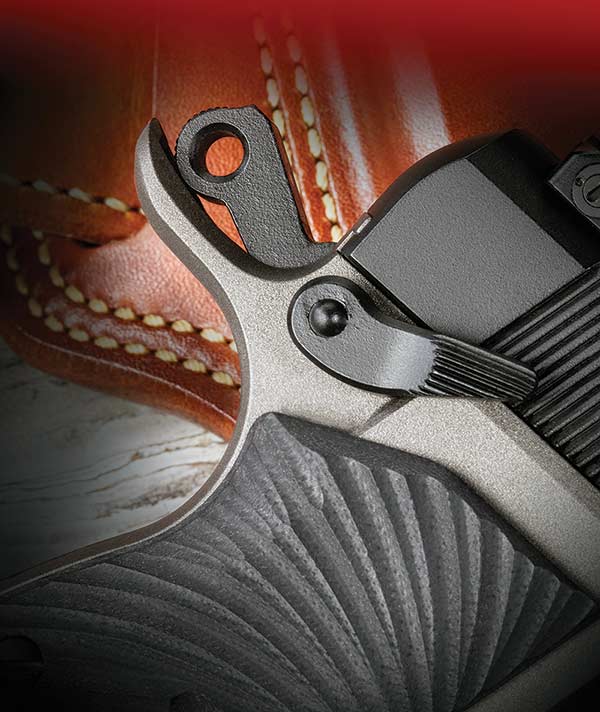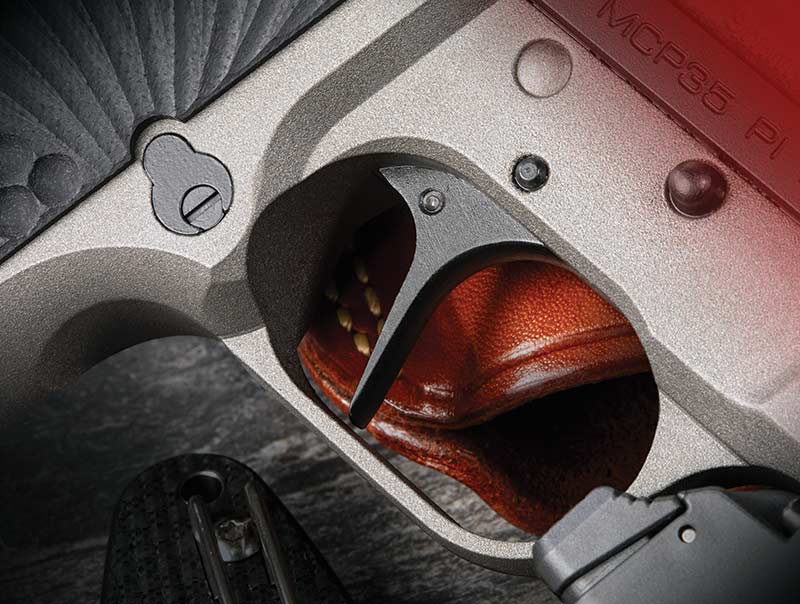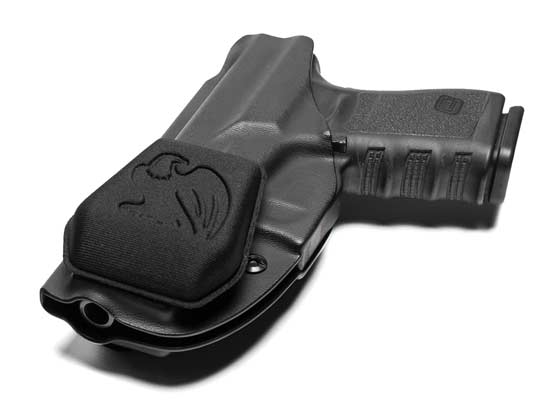Modernizing a Classic
A New “High Power” From Girsan: MCP35 PI LW OPS
Last year, I attended the Celebration Exotic Car Festival. It’s a show that redefines the phrase “high-end.” Ferraris, McLarens, Bugattis, Lamborghinis, Jags, Vettes of all eras and lots, lots more. The highlight of the show was a Ferrari 250 GTO, currently valued at over $80 million. So, yes, I had the opportunity to look at a lot of motorcar magnum opuses I’ll never be able to afford. But to be clear, that didn’t reduce the joy level of the experience one iota. On other days, I’ll happily wander the lots looking at Fords and Chevys, too, and appreciate that they are within financial reach.
This is much like the process we here at Handgunner use to select cover guns. Sometimes, it’s fun to uncover the elegance of a $5,000 hand-built masterpiece of craftsmanship. Other times, we make sure to choose guns within reach of most of our readers (and staff!). It’s all very deliberate and, we hope, strikes a balance between covering practical and affordable guns, punctuated on occasion by the pricier rarity that’s just plain fun to look at.
This time around, we’re choosing to uncover the joys of a modern take on the classic Hi-Power design, and it absolutely falls into the practical and affordable category. The Girsan High Power (trademarked using that exact spelling, so we’ll write “High Power” throughout this article when talking about this model specifically) is, like many modern 1911s, a timeless core design with 21st-century upgrades. If you’re looking for a replica of an original Hi-Power, this isn’t it. If you’re looking for how a Hi-Power has evolved over the past 100 years, check this one out. I have to say, after my first range outing with it, my gut observation was, “Hey, this is kind of cool!” With all that said, let’s get on with the business.
Modernized High Power
There’s an elephant in the gun room, so let’s address it head-on. This pistol (a small family, actually, but we’ll get to that in a minute) is not a faithful reproduction of John Moses Browning’s (may he rest in peace) and Dieudonné Saive’s original masterpiece. It’s not supposed to be. Rather, like most 1911s these days, it’s a modernized version of a classic design. It’s clear the designers stepped back and pondered the following. “Hmmm. If we were to take the basic design of the original Hi-Power and add and remove features we’ve learned about over the past century, what would it look like now?”
And so they did. The new iteration contains a nifty feature set optimizing this pistol for carry and defensive use. Don’t read too much into that; unlike many “small and light” carry pistols, this one is fun and pleasant to shoot, so even if you don’t carry, it makes a great recreational pistol in addition to its defensive features.
Carry Ready
Girsan has been making Hi-Powers for a while now, so this model isn’t a grand market entrance to the space. It is, however, a significant iteration of their offering. The MC P35 PI LW OPS is significantly lighter than its more traditional models owing to an aluminum frame mated with, as you’d expect, a steel slide and barrel assembly. The difference is about half a pound, depending on the exact model. It’s also a bit smaller, measuring about 1/2″ shorter than a Springfield Armory P35 I have sitting here for comparison. The height is about the same using wooden ruler math; I’m sure the micrometer might show a difference too slight for practical consideration.
While a bit smaller and lighter than the original, it’s still a “full size” gun, as described by my ability to get all fingers on the grip comfortably. My hands take a size large glove for reference, and I can easily fit all fingers on the grip. They go right to the bottom, but the fit is natural and comfortable. Just to be clear, gun marketers would call this one a “compact” or perhaps a “mid-size.” I’m only referring to hand fit with my “full size” reference.
Speaking of gripping, the grip panels are made from G10. I couldn’t tell you if Grand Master Browning would have chosen this for his design, but since it didn’t exist at the time, we’ll chalk it up to one of the “modernized” feature choices. The grip feel and appearance are modern and fantastic. I would describe the color as a blend of gray and blue, and the texture is moderate, so it won’t tear up your midsection or clothing if you carry it inside the waistband.
While we’re talking about exterior stuff, I’ll mention the feature so obvious in Rob’s beautiful photos here — the accessory rail. Light capable? Check. Laser capable? Check. Bayonet capable? If that’s how you roll. While it will have some impact on holster considerations, the rail provides options for defensive configurations. Are you seeing a parallel to the modernization of the 1911 platform?
A Look Inside
Let’s hit the big one first. This is not a unique feature of this High Power, but it’s significant. While the French originally demanded a magazine disconnect blocking the pistol from firing with the magazine removed, the feature added some extra baggage to what could have been a delightful trigger press. This pistol has no such thing. And there was much rejoicing.
There are two safety levers, one on each side, so the pistol is ready out of the box for right- or left-hand shooting, not just reversible on demand. The safety is easy to disengage with a downward thumb sweep without changing your firing grip. Re-engaging the safety takes more effort — I have to adjust my hands to get my thumb in a good position to shove it back into the “safe” position. You’re not going to engage the safety inadvertently or with a casual upward motion of the thumb. I suppose user preference will determine if this is a good thing or not.
The Hi-Power design always has an “extended” slide lock/release lever owing to the forward placement of the slide-stop pin. Normally, the operator end of the lever is subtle, discreet and relatively flat. The Girsan modern take shapes that section more like a miniature gas pedal on a race gun. A 45-degree “button” faces the shooter and serves as a generously sized pad for easy thumb activation. I found I could operate it with ease without adjusting my firing grip. The larger surface area and leverage made overcoming spring pressure friction a snap.
Like other Hi-Power designs, the hammer is skeletonized. This one is shielded by a full-length beavertail, which unambiguously separates the hammer surface from the web of your hand, no matter how high the firing grip. No hammer bite here.
One thing you don’t want to change is the magazine, at least from a compatibility standpoint. While I did not have the opportunity to mix and match magazines at the range, a careful visual inspection of 15-round SA-35 magazines illustrated identical construction as far as shape, cuts and dimensions go. So, if you’re keeping track, that yields a 16-round carry capacity factoring in the 15 in the magazine plus one in the chamber.
Trigger Observations
The trigger takes enhancements into the 21st century as well, in some ways. You’ll notice right off the bat the lack of the more traditional aggressively curved trigger face in favor of a straight trigger. I’m not only okay with this, I welcome it. Yeah, I know, it’s not traditional, and the curved trigger feels great when fondling the gun. But for some reason, I just don’t shoot the generously hooked trigger as well as I do a “flatter” trigger face. Got me. This is a completely subjective thing; your mileage may vary.
As for the trigger sensation, it’s on the heavier side, measuring about 6 lbs. An SA-35 I had handy yielded a 5-lb. pull right on the nose, so the Girsan is definitely weightier, and I did have to focus a bit more when shooting groups for accuracy. Should I buy this one, I’ll get a little polish and touchup done on the trigger. With its manual safety design, I’d have no qualms about carrying this with a trigger in the 4-lb. neighborhood.
Optics Ready!
I suppose John Moses could have added a facility for a candle-powered optical sight, but it might have been a bit impractical. The Girsan iteration is pre-cut and ready for modern red dot sights. More specifically, the slide is cut for the Trijicon RMSc platform, which has since been adopted by other sight manufacturers. In the example shown and shot here, I used a Holosun EPS Carry sight, which fit handily using the mounting plate and screws included with the optic.
The pistol comes out of the box with modern sights, a ramped black ready sight machined into the optics cut cover plate and a fiber-optic front sight. Just a quick note on fiber optics. If you prefer a different color or manage to break one of the tubes, they’re super easy to replace using nothing more than a knife and a lighter.
Shooting Performance
While a steel Hi-Power tends to feel a bit muzzle-heavy (not a bad thing for shooting), the MC P35 LW OPS, with its aluminum frame and shorter overall length, feels naturally balanced in the hand. It’s a comfortable gun to shoot—a lot. Even with its lighter weight, 9mm ammo is tame in this pistol, and it won’t cause recoil fatigue during extended range sessions. Subjectively speaking, I found it easy to shoot well. I usually get used to a new pistol by shooting dirt clods on the 25-yard berm. Okay, I admit it, because … it’s fun. But it’s a good way to get acclimated and put some freehand rounds through a pistol using different one- and two-hand grips to begin the process of checking reliability. With this method of “fun shooting” using the Holosun optic, I found it easy to blow up clods with relative ease.
Moving to a more formal (and measurable) regimen, I broke out the brand-new Garmin Xero C1 Pro Doppler Radar Chronograph and set up targets at 25 yards. For velocity and accuracy testing, I used the most excellent Ransom Multi-Caliber rest to keep things steady. I also left the Holosun in place to help keep my aging eyes and deteriorating sight picture out of the results. This sight has a 32 MOA ring surrounding a 2 MOA center dot, so at 25 yards, the dot offers a precise sight picture on target — it only covers about 1/2″ at that distance.
Norma Hexagon is a match-grade load, in this version, topped with a 124-grain 9mm projectile. From the MC P35, the Garmin clocked it at an average of 1,018.3 fps, and accuracy measured 2.22″ for a five-shot group at 25 yards. Next up was the Norma MHP, a light-for-caliber round designed to expand aggressively. The 108-grain bullet averaged 1,113 fps and printed a 2.06″ group. Wanting to vary bullet weight, I also tried the Federal Syntech Match 150-grain option. Those clocked in at an average of 888 fps owing to the significantly heavier bullets. The five-shot group measured 1.59″ at 25 yards. Another Federal option, the NATO 124-grain load, moved at a speedy 1,155 fps and delivered a 2.77″ group. The winner of the day for accuracy was the Black Hills 115-grain JHP EXP ammo. Moving at an average of 1,135.1 fps, it printed an impressive 1.12″ five-shot group at 25 yards. I’ll call that excellent from a lightweight, compact pistol!
A Growing Family
Girsan now offers a family of High Power pistols. The new brood includes two different MC P35 PI LW OPS models and two new MC P35 PI LW Match pistols. The PI LW OPS you’re looking at in these photos is the Two-Tone Tungsten model, which retails for $772. You can also order the same pistol in all black (still an aluminum frame) for a retail price of $749.
The Match pistols are available in similar pairing with a Tungsten Two-Tone ($772) and an all-black ($749) version. The Match models also use aluminum frames but do not include the Picatinny accessory rail.
We’ll see how street prices shake out on these new pistols, but even at full MSRP, they represent a solid bargain for what you’re getting. If you’re a single-action aficionado and appreciate the classic Hi-Power design, the Girsan High Power will make a fine carry option equally at home on the recreation range too.











